Streamlining Your Strategy with a Balanced Scorecard PowerPoint Template
Download a free Balanced Scorecard PowerPoint template to easily track and measure your organization's performance across financial, customer, internal processes, and learning and growth perspectives.
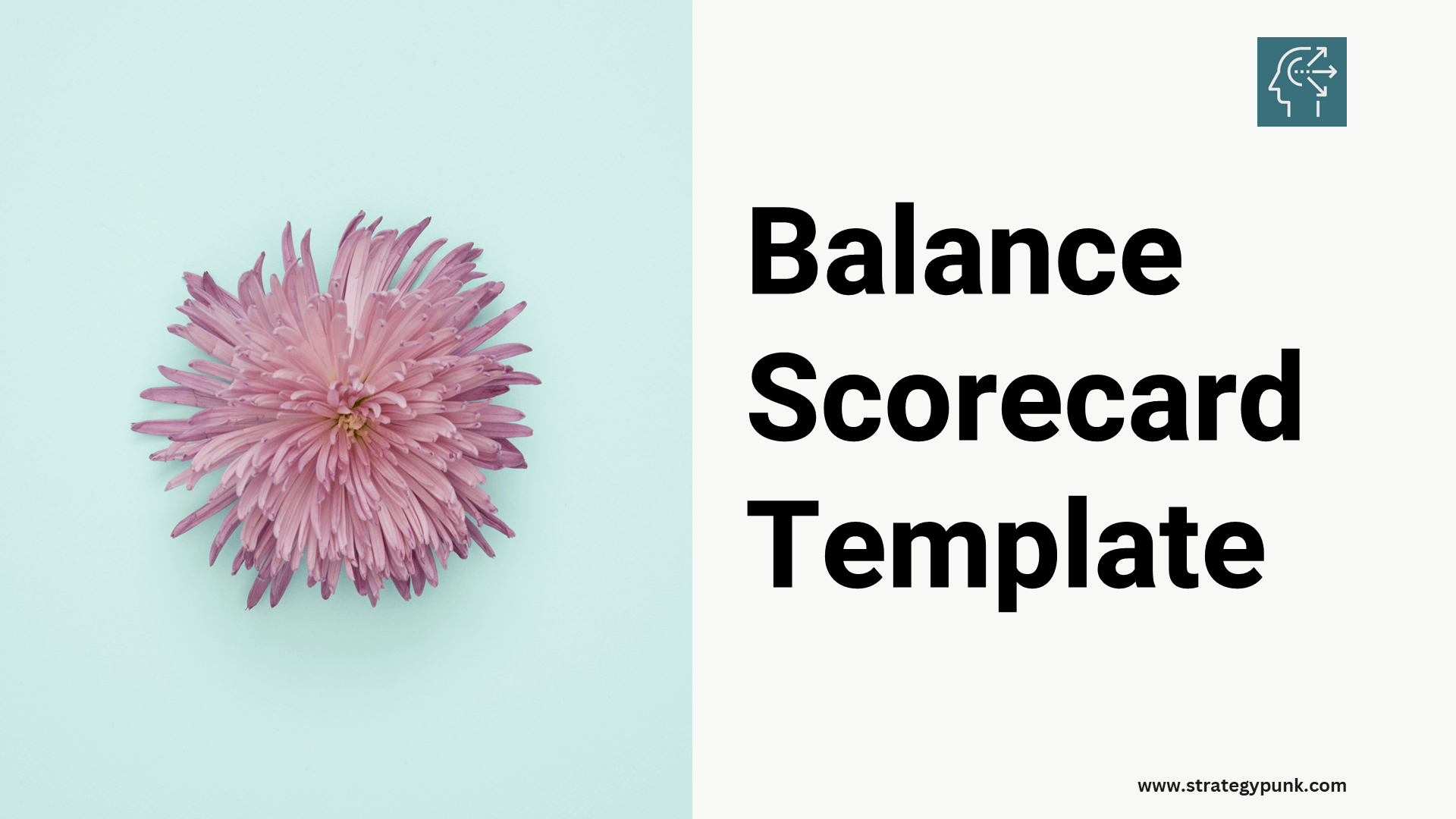
Understanding the Balanced Scorecard Framework: A Brief Overview
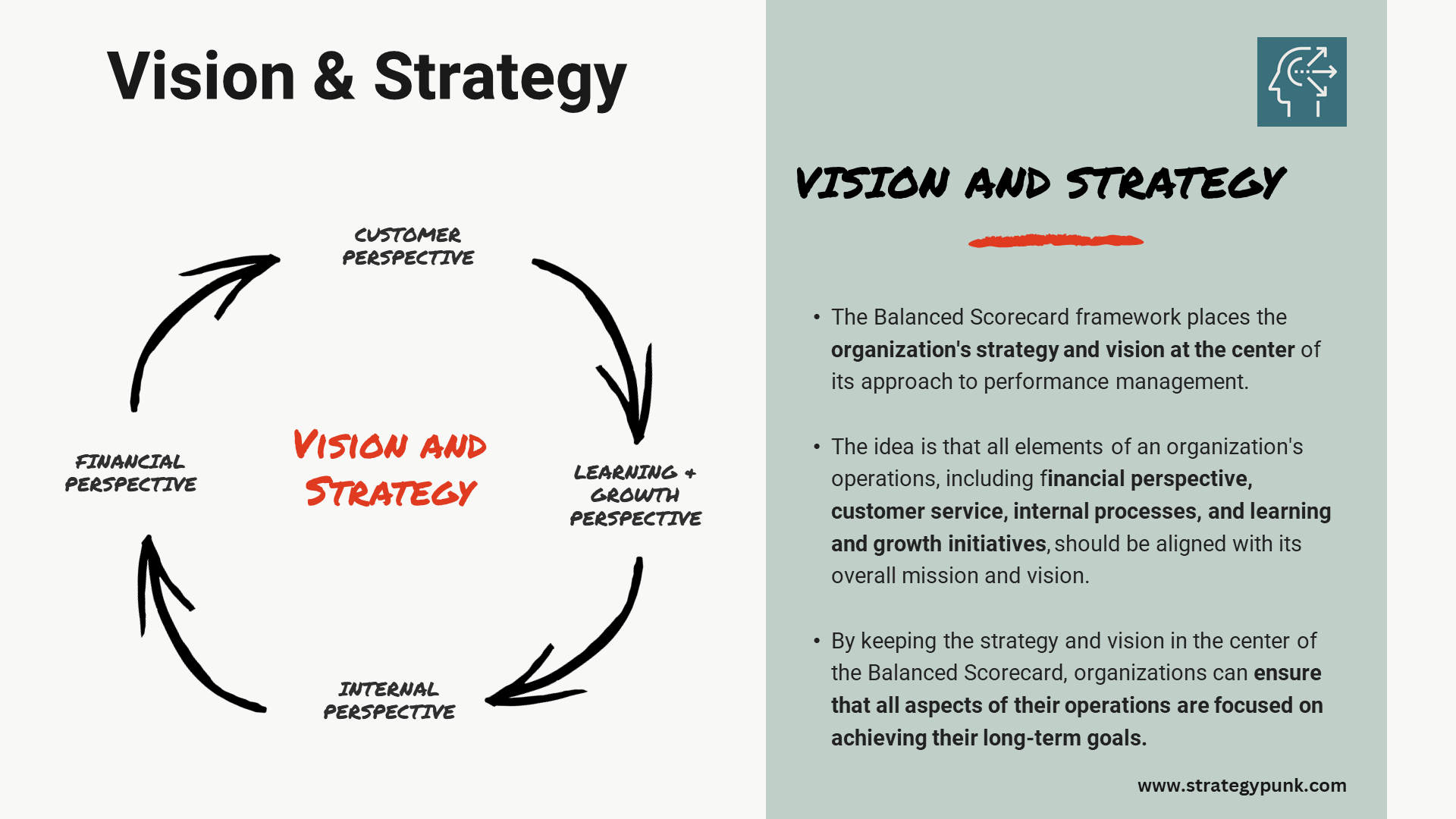
The Balanced Scorecard framework places the organization's strategy and vision at the center of its approach to performance management.
The idea is that all elements of an organization's operations, including financial metrics, customer service, internal processes, and learning and growth initiatives, should be aligned with its overall mission and vision.
By keeping the strategy and vision at the center of the Balanced Scorecard, organizations can ensure that all aspects of their operations are focused on achieving their long-term goals.
What are the 4 Components of a Balanced Scorecard?
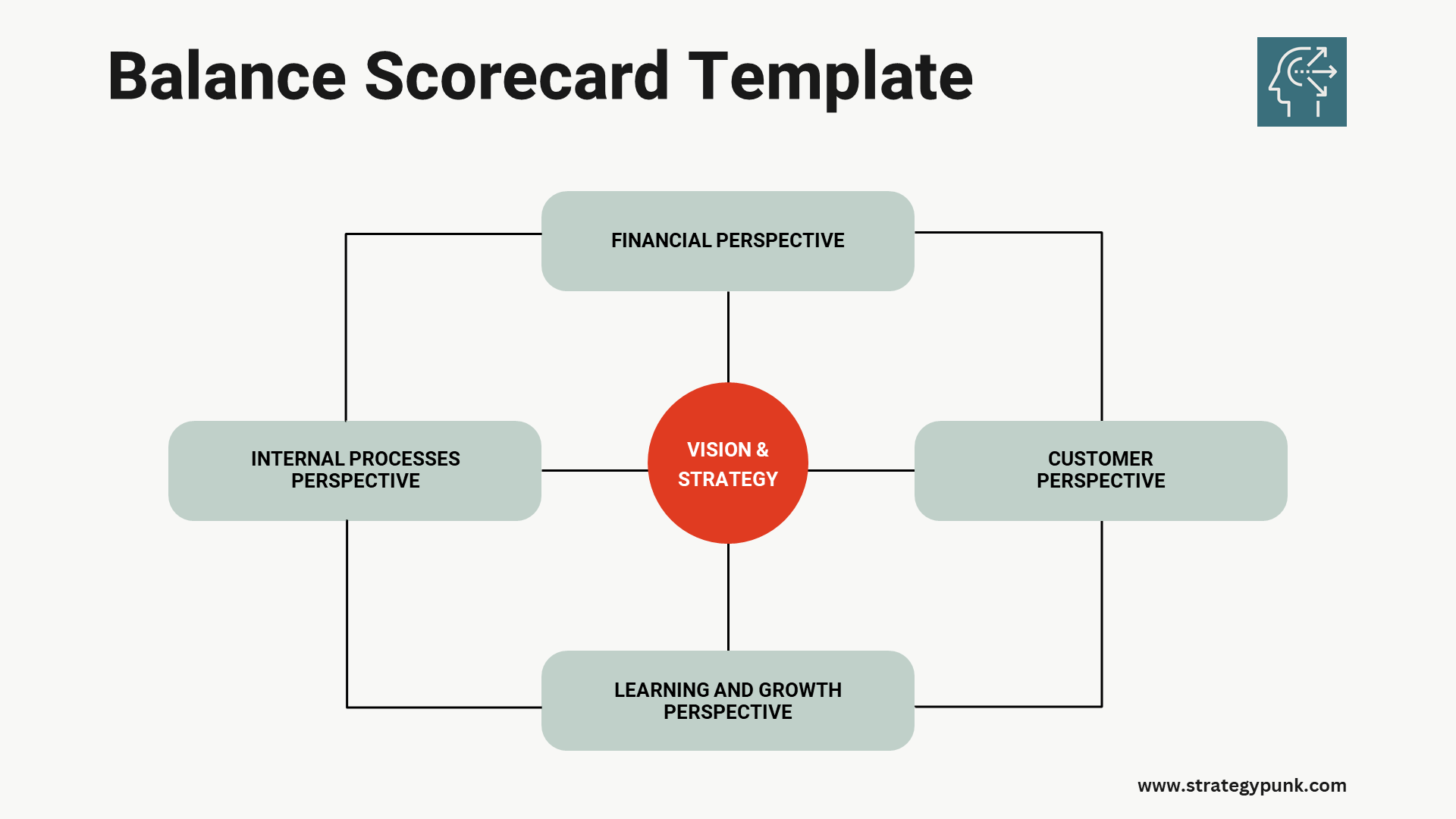
The four components of a Balanced Scorecard are:
- Financial Perspective: This component focuses on financial objectives, such as revenue growth, profitability, and return on investment.
- Customer Perspective: This component focuses on customer satisfaction, loyalty, and retention, as well as strategies for acquiring new customers.
- Internal Processes Perspective: This component focuses on internal processes that drive the organization's performance, such as operational efficiency, quality, and innovation.
- Learning and Growth Perspective: This component focuses on the organization's ability to learn, grow, and adapt to changes, including employee training and development, technology upgrades, and innovation.
Together, these components provide a comprehensive view of the organization's performance, enabling it to make informed strategic decisions and improve overall performance.
Balanced Scorecard PowerPoint Template
In the PowerPoint Template above, each perspective has its own set of goals and measures and status tracking.
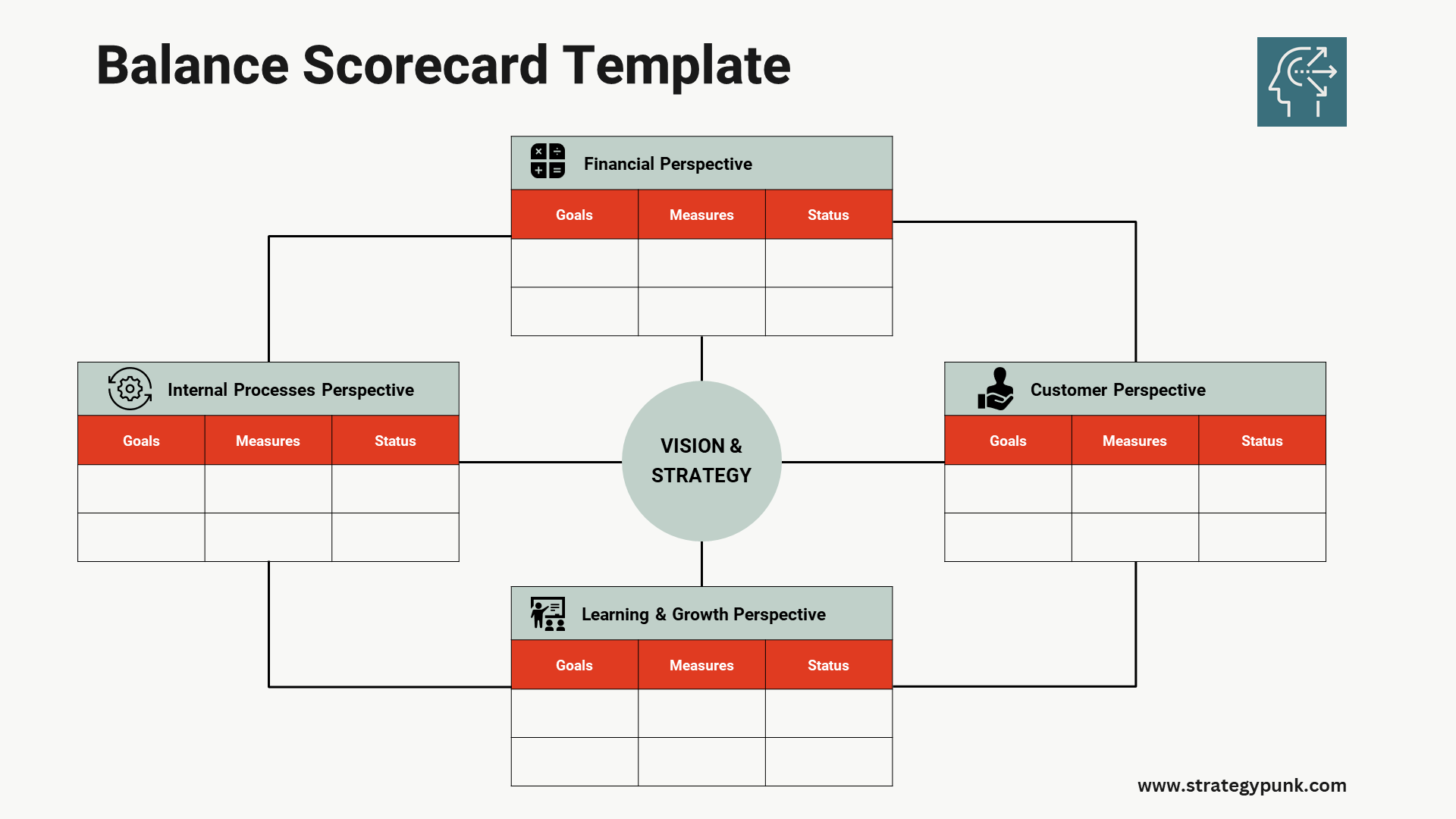
- The financial perspective focuses on the organization's financial goals, such as revenue growth, profitability, and return on investment.
- The customer perspective focuses on customer satisfaction, loyalty, and retention.
- The learning and growth perspective focuses on the organization's ability to learn, grow, and adapt to changes, such as employee training, development, and innovation.
- The internal processes perspective focuses on the internal processes that drive the organization's performance, such as operational efficiency and quality.
By measuring and tracking performance across all four perspectives, the balanced scorecard provides a comprehensive view of the organization's performance, allowing it to make informed strategic decisions and improve overall performance.
How do I create a balanced scorecard template?
Here is our step-by-step approach for using our Balanced Scorecard PowerPoint Template.
- Define your organization's mission, vision, and strategic goals.
- Identify the key performance indicators (KPIs) that align with each strategic goal.
- Categorize the KPIs into four perspectives: financial, customer, internal processes, and learning and growth.
- Add the perspective headings and identify the KPIs associated with each perspective.
- Assign goals and targets for each KPI, ensuring they are specific, measurable, achievable, relevant, and time-bound (SMART).
- Determine how you will measure and track progress towards each goal, including which data sources you will use.
- Customize the template to include any additional metrics or data relevant to your organization.
- Create visual elements, such as charts or graphs, to display the data in a clear and easy-to-understand format.
- Test the completed template to ensure it accurately reflects your organization's goals and objectives and can be easily updated and maintained over time.
By following these steps, you can create a Balanced Scorecard using our template that aligns with your organization's strategy, helps to track progress towards your goals, and provides a clear and consistent direction for your business.
What KPIs are used for the Internal Processes Perspective of the Balanced Scorecard?
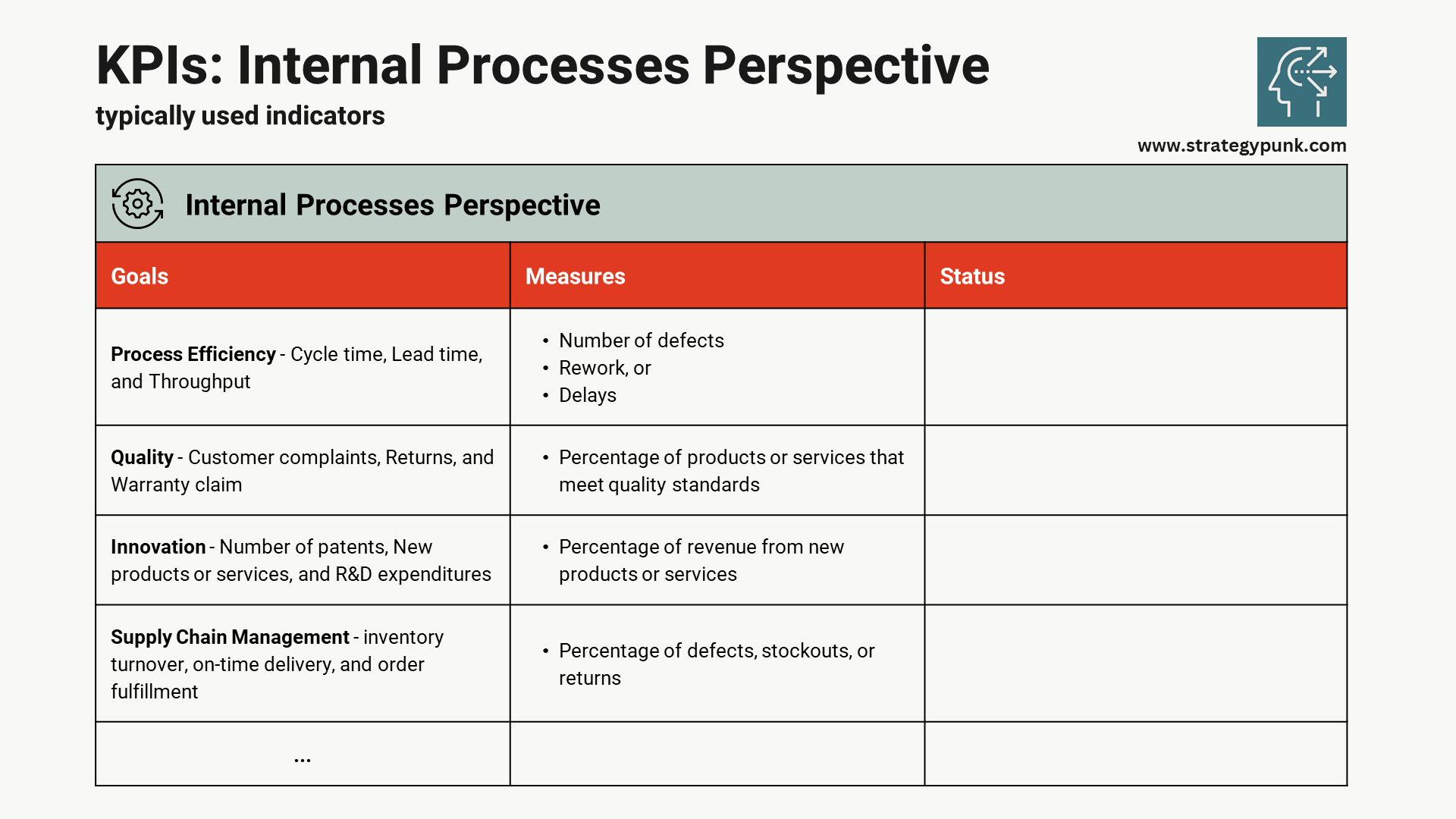
The Internal Processes Perspective in a Balanced Scorecard focuses on the key internal processes that drive an organization's performance.
Here are typical KPIs, goals, and measures that organizations might use to track performance in this perspective
- Process Efficiency: The goal is to reduce waste, increase efficiency, and streamline processes. KPIs could include cycle time, lead time, and throughput. Measures could include the number of defects, rework, or delays.
- Quality: The goal is to maintain high-quality standards and minimize defects. KPIs could include customer complaints, returns, and warranty claims. Measures could include the percentage of products or services that meet quality standards.
- Innovation: The goal is to foster creativity and market new products and services. KPIs could include the number of patents, new products or services, and research and development expenditures. Measures could include the percentage of revenue from new products or services.
- Supply Chain Management: The goal is to optimize the supply chain and manage suppliers effectively. KPIs could include inventory turnover, on-time delivery, and order fulfillment. Measures could include the percentage of defects, stockouts, or returns.
- Regulatory Compliance: The goal is to comply with relevant laws and regulations. KPIs could include the number of violations or fines. Measures could include the percentage of audits passed or certifications received.
These are just a few examples of the KPIs, goals, and measures organizations might use to track performance in the Internal Processes Perspective.
What are typical KPIs used for the Financial Perspective of the Balanced Scorecard?
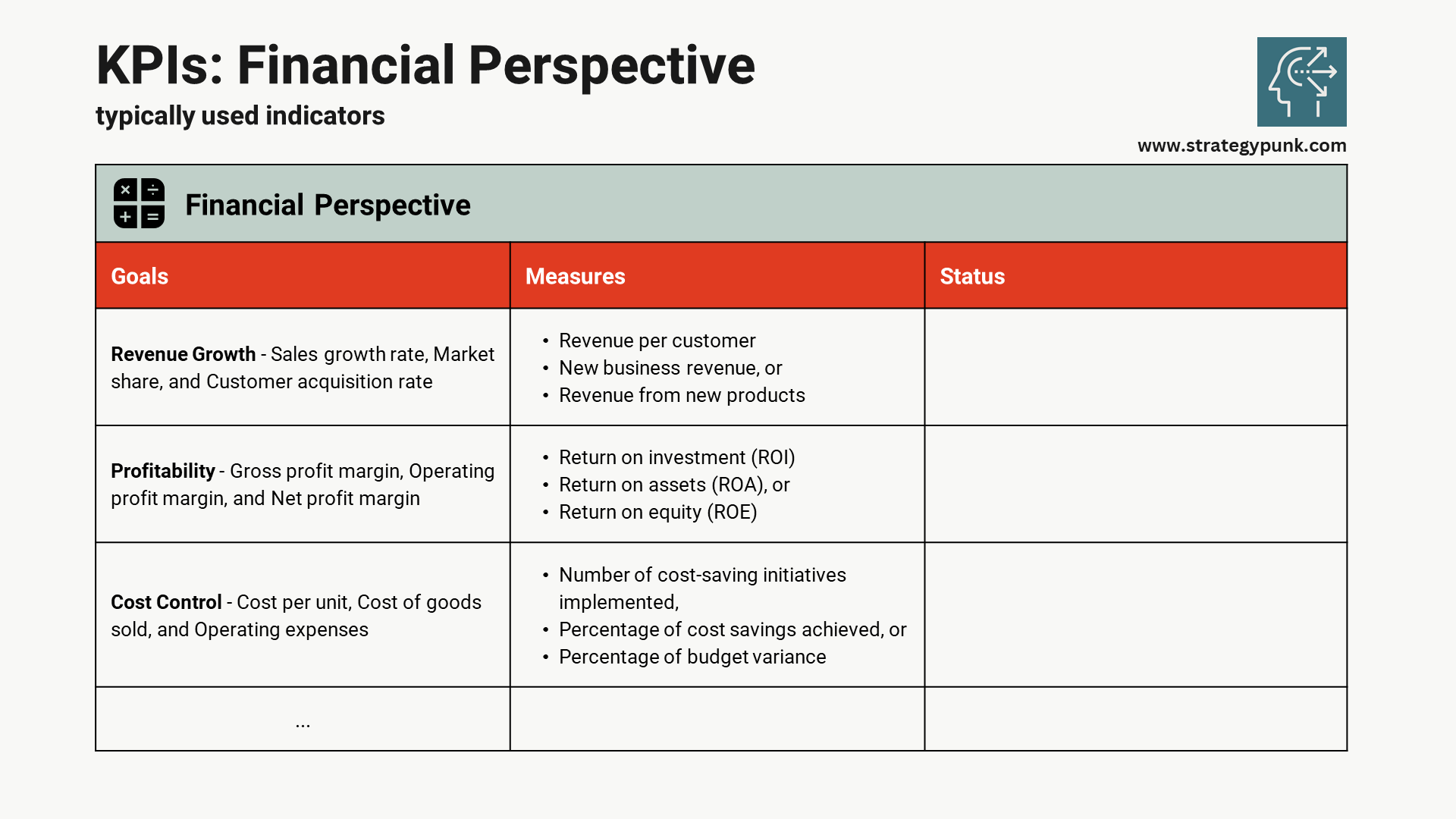
The Financial Perspective in a Balanced Scorecard focuses on financial objectives and measures the success of an organization's financial strategy.
Here are some typical KPIs, goals, and measures that organizations might use to track performance from this perspective:
- Revenue Growth: The goal is to increase revenue over time. KPIs could include sales growth rate, market share, and customer acquisition rate. Measures could include revenue per customer, new business revenue, or new products.
- Profitability: The goal is to generate a profit for the organization. KPIs could include gross profit margin, operating profit margin, and net profit margin. Measures could include return on investment (ROI), return on assets (ROA), or return on equity (ROE).
- Cost Control: The goal is to control costs and minimize expenses. KPIs could include cost per unit, cost of goods sold, and operating expenses. Measures could include the number of cost-saving initiatives implemented, the percentage of cost savings achieved, or the percentage of budget variance.
- Cash Flow: The goal is to manage cash flow effectively. KPIs could include cash conversion cycle, working capital, and days sales outstanding (DSO). Measures could include the percentage of cash reserves, cash balance, or accounts receivable outstanding.
- Asset Utilization: The goal is to optimize asset utilization. KPIs could include inventory turnover, asset turnover, and depreciation. Measures could consist of the capacity utilization percentage, asset utilization rate, or asset productivity.
These are just a few examples of the KPIs, goals, and measures organizations might use to track performance in the Financial Perspective.
What are typical KPIs used for the Customer Perspective of the Balanced Scorecard?
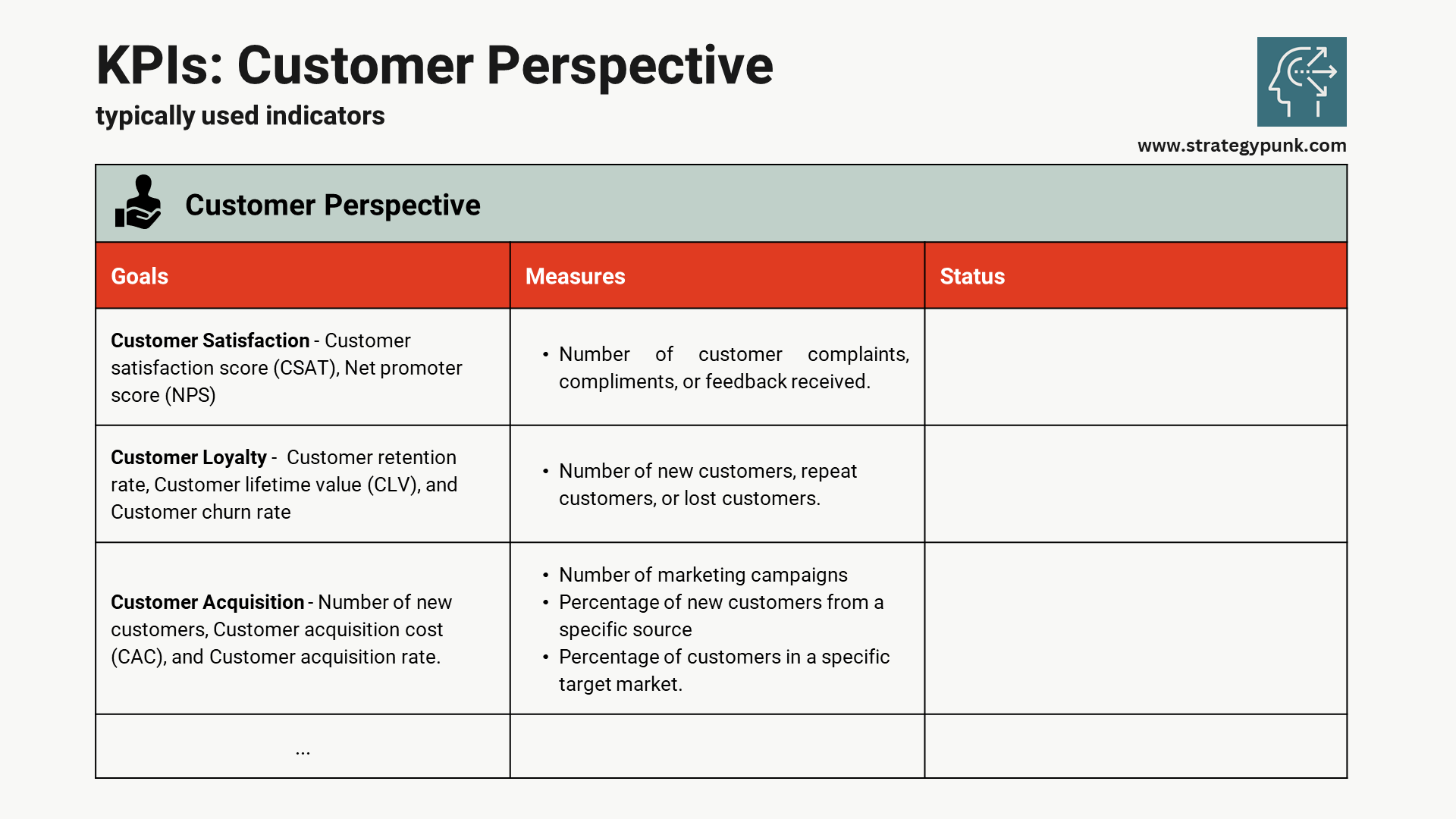
The Customer Perspective in a Balanced Scorecard focuses on customer satisfaction, loyalty, and retention.
Here are some typical KPIs, goals, and measures that organizations might use to track performance from this perspective:
- Customer Satisfaction: The goal is to meet or exceed customer expectations. KPIs could include customer satisfaction score (CSAT), net promoter score (NPS), and customer effort score (CES). Measures could include the number of customer complaints, compliments, or feedback received.
- Customer Loyalty: The goal is to increase customer loyalty and retention. KPIs could include customer retention rate, lifetime value (CLV), and churn rate. Measures could include the number of new, repeat, or lost customers.
- Market Share: The goal is to increase the organization's market share. KPIs could include the percentage of market share, market growth rate, and market penetration rate. Measures could include the number of new customers, the percentage of market share growth, or the percentage of customers in a specific target market.
- Brand Perception: The goal is to improve the organization's brand perception. KPIs could include brand recognition, brand loyalty, and brand reputation. Measures could include the percentage of customers who recognize the brand, the percentage of customers who prefer the brand, or the percentage of positive reviews or mentions.
- Customer Acquisition: The goal is to attract new customers. KPIs could include the number of new customers, customer acquisition cost (CAC), and customer acquisition rate. Measures could include the number of marketing campaigns, the percentage of new customers from a specific source, or the percentage of customers in a particular target market.
These are just a few examples of the KPIs, goals, and measures organizations might use to track performance in the Customer Perspective.
What KPIs are used for the Learning & Growth Perspective of the Balanced Scorecard?
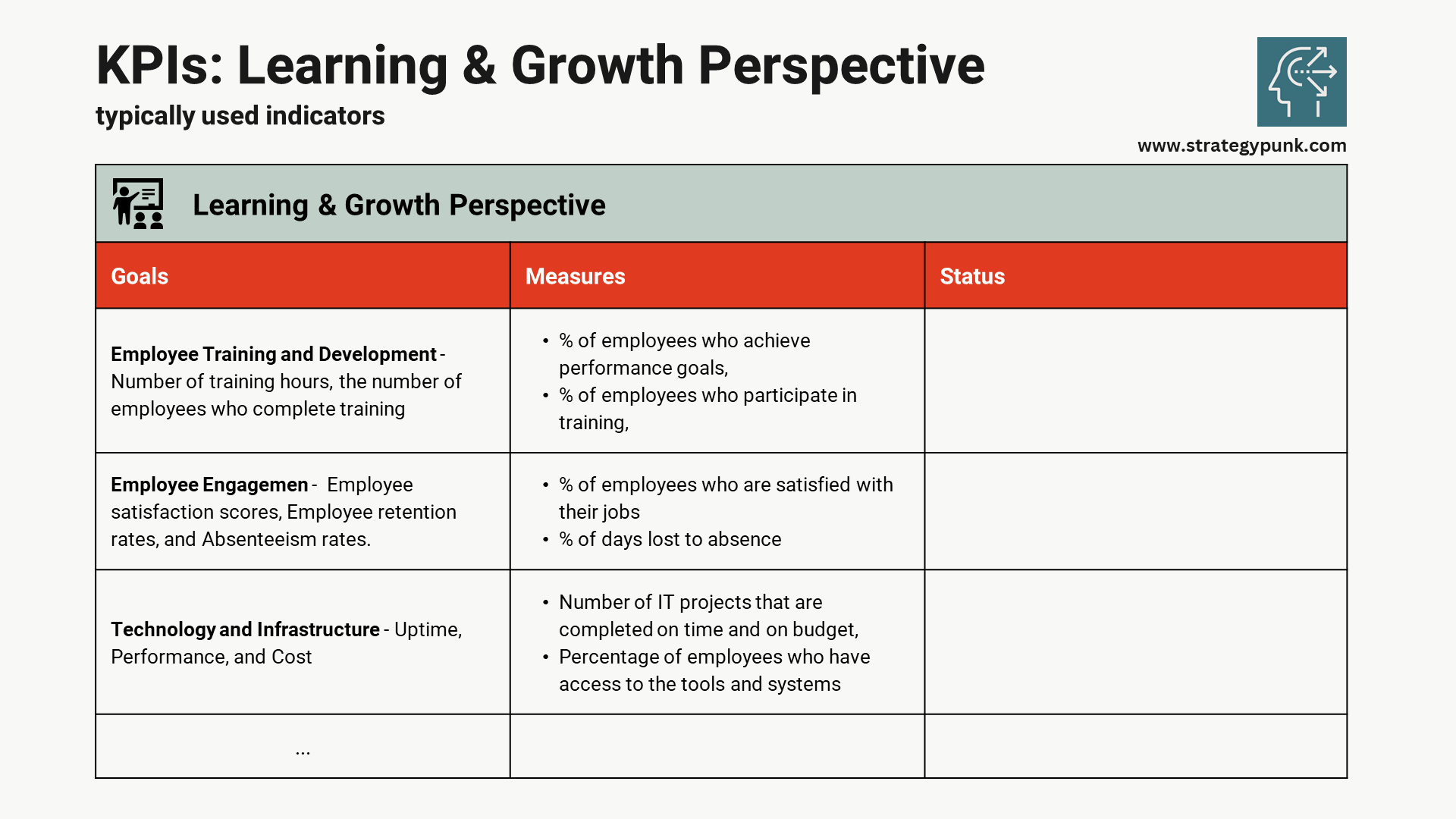
Here are some typical KPIs, goals, and measures that organizations might use to track performance from this perspective:
- Employee Training and Development: The goal is to provide employees with ongoing training and development opportunities. KPIs could include the number of training hours, the number of employees who complete training, and the percentage of employees who receive promotions. Measures could include the percentage of employees who achieve performance goals, the rate of employees participating in training, or the cost of training per employee.
- Employee Engagement: The goal is to increase employee engagement, job satisfaction, and retention. KPIs could include employee satisfaction scores, retention rates, and absenteeism rates. Measures could include the percentage of employees who are satisfied with their jobs, the percentage of employees who stay with the organization, or the percentage of days lost to absence.
- Knowledge Management: The goal is to effectively capture and share organizational knowledge. KPIs could include the number of best practices implemented, the number of employees who share knowledge, and the number of communities of practice established. Measures could include the percentage of employees who have access to knowledge, the percentage of successful knowledge management initiatives, or the percentage of employees who participate in communities of practice.
- Innovation: The goal is to foster organizational innovation and creativity. KPIs could include the number of new products or services developed, the number of patents filed, and the number of new ideas submitted. Measures could include the percentage of revenue from new products or services, the percentage of employees who participate in idea generation, or the percentage of successful ideas.
- Technology and Infrastructure: The goal is to ensure that the organization's technology and infrastructure support its strategic goals. KPIs could include uptime, performance, and cost. Measures could include the number of IT projects that are completed on time and budget, the percentage of employees who have access to the tools and systems they need, or the percentage of infrastructure assets that are fully utilized.
These are just a few examples of the KPIs, goals, and measures organizations might use to track performance in the Learning and Growth Perspective.
Balanced Scorecard Template
Free Template in PowerPoint, Google Slides and PDF format
Sign up for our newsletter to access a free Balanced Scorecard template.
Easily track and measure your organization's performance across financial, customer, internal processes, and learning and growth perspectives.
Align your KPIs with your strategic goals and make informed decisions to improve your overall performance.
Once you sign up, you will see the link to the free download below.





